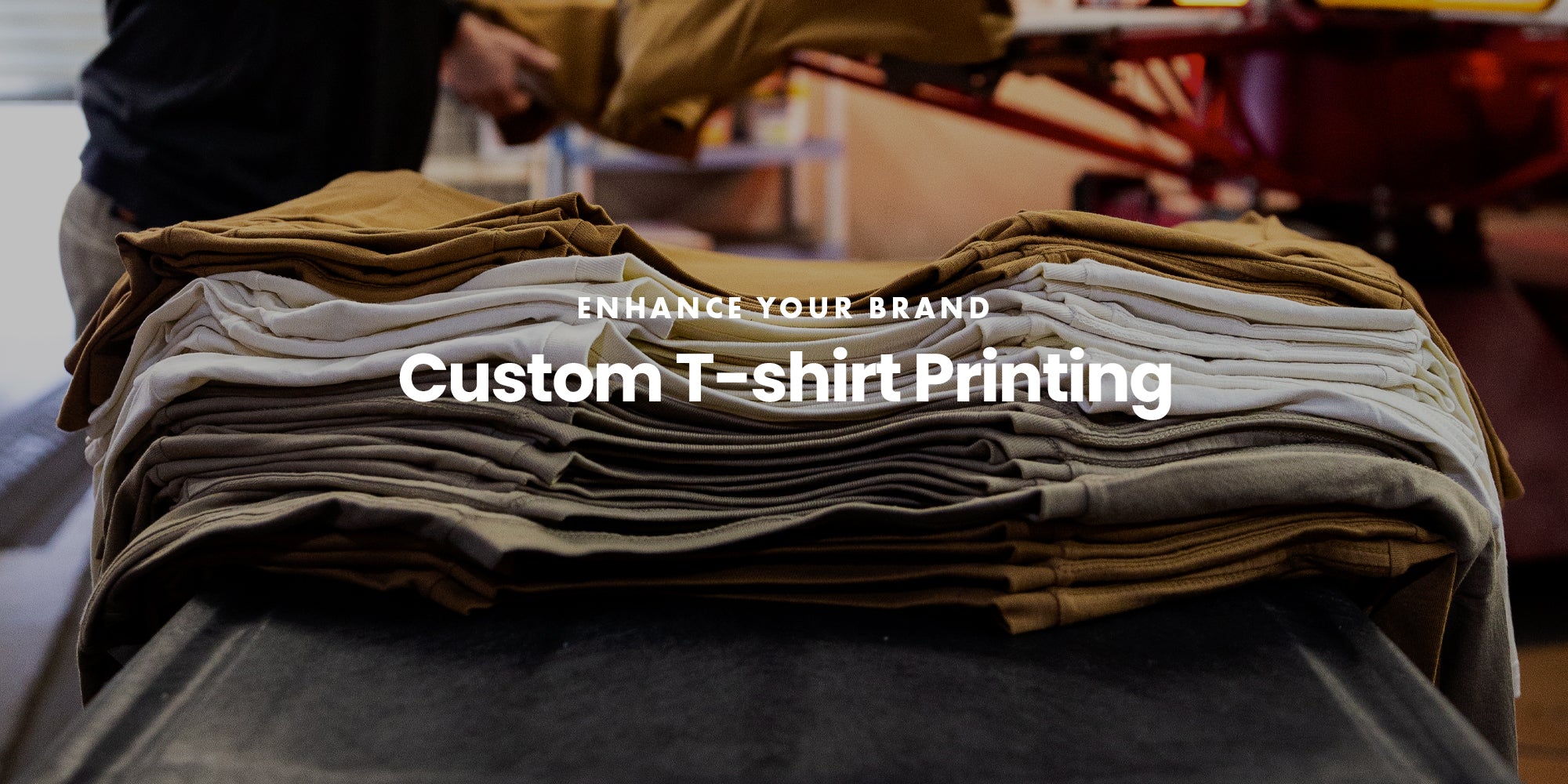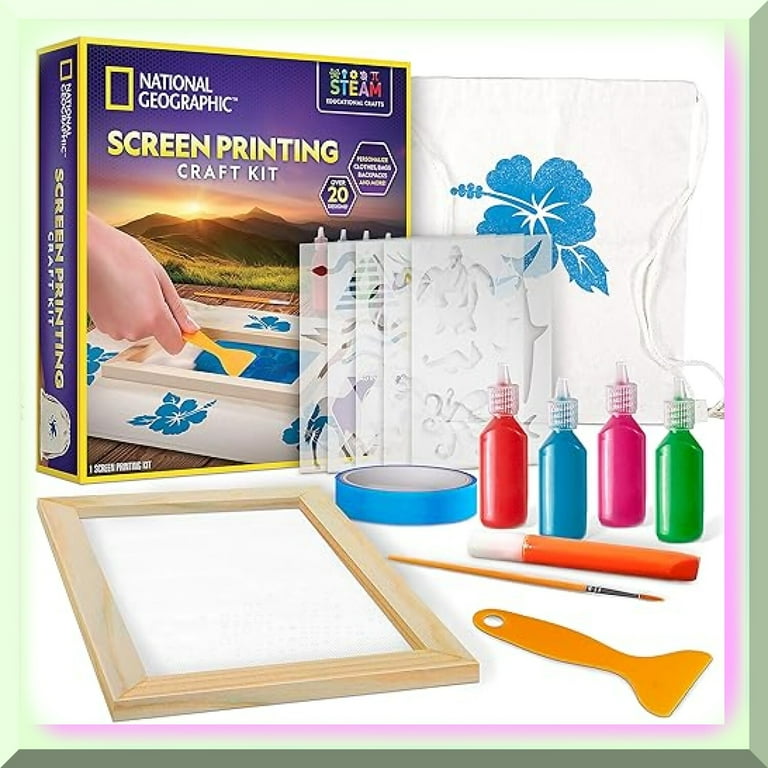Custom Screen Printing for Unique Promotional Merchandise
Display Printing Uncovered: Every Little Thing You Required to Find Out About T-Shirt and Garment Printing Methods
If you have actually ever before questioned exactly how those vivid layouts wind up on your preferred t-shirts, you remain in the appropriate place. Display printing is an interesting method that integrates art with technique, supplying endless possibilities for creativity. Understanding the basics, from tools to ink selections, can substantially impact your outcomes. Prepared to discover the crucial aspects that make screen printing an art form? Let's uncover the details that can elevate your tasks.
The Fundamentals of Display Printing: Just How It Functions
When you dive right into display printing, you'll uncover it's both an art and a science. At its core, screen printing entails creating a pattern, or screen, that permits ink to travel through only in specific areas (screen printing kit). You begin by choosing your design and preparing your screen with a light-sensitive emulsion. When you expose this emulsion to light, it hardens, leaving your style as an adverse area.
Next, you'll mix your inks and prepare your printing surface area. Position the display over the material, then use a squeegee to press ink through the screen onto the garment. This procedure calls for precision, as you want clear, vibrant prints. After printing, you'll heal the ink with heat, guaranteeing it abides by the material and lasts through washes. Each step is important, and understanding them will certainly raise your screen printing abilities, changing easy garments right into special, expressive items.
Sorts Of Screen Printing Methods
Once you understand the basics of display printing, it's time to explore the various techniques that can elevate your designs. One prominent method is typical display printing, where ink is pushed with a stenciled screen.
Another choice is plastisol printing, understood for its resilience and vivid shades, making it a favored for numerous brand names. Experiment with halftone printing to develop slope effects and intricate styles.
Crucial Equipment for Display Printing
To achieve sensational results in display printing, having the ideal tools is fundamental. You'll require a tough display printing frame, which holds the mesh that transfers your layout onto the garment. Next, invest in high-grade mops; these are vital for using ink evenly across the display. You'll likewise require a great direct exposure unit to develop your screens, as well as a washout booth for cleaning them after use. A reliable warmth source, like a conveyor dryer or warmth press, is essential for treating your prints to guarantee durability. Do not neglect a correct workspace, furnished with tables and storage space for your supplies. Lastly, safety gear, such as masks and handwear covers, will maintain you secure from chemicals and inks. With the right tools, you'll be well on your way to creating professional-quality prints.
Choosing the Right Inks and Products
When picking inks and materials for display printing, you need to take into consideration the kind of ink that works finest for your task. Think of fabric compatibility to assure your designs look last and terrific long. Explore environment-friendly ink choices to make your printing procedure much more lasting.
Kinds Of Display Inks
Selecting the right screen ink is important for accomplishing vibrant, durable prints that fulfill your job's needs. There are a number of types of display inks to take a look at. Specialty inks, such as glow-in-the-dark or metal, can add one-of-a-kind impacts to your layouts.

Textile Compatibility Considerations
Understanding textile compatibility is crucial for accomplishing high-quality display prints, particularly given that different materials respond distinctively to different inks. When choosing inks, think about the fabric kind-- cotton, polyester, or blends. For cotton, water-based inks work well, supplying softness and breathability. Polyester, on the various other hand, often calls for plastisol inks for better bond and lively shades. If you're publishing on blends, you might need to utilize a combination of both kinds. Constantly examine your inks on sample fabric to guarantee they stick correctly and maintain shade integrity. Additionally, bear in mind that textile weight and texture can affect the last outcome, so choosing the ideal ink and product combination is vital for your job's success.
Eco-Friendly Ink Options
Green inks are ending up being a popular choice for display printers who intend to decrease their environmental impact while preserving high quality. When selecting inks, take into consideration water-based inks, which are much less unsafe and much easier to tidy up compared to conventional solvents. These inks bond well with textiles, delivering vibrant results without hazardous chemicals. You might additionally explore eco-solvent inks that use less unstable natural compounds (VOCs), making them a more secure alternative for both your health and wellness and the earth.
Additionally, seek inks made from renewable energies, such as soy or vegetable-based options. By picking the ideal inks and products, you'll not only develop magnificent styles however additionally add to a more lasting printing process. Make the button, and your prints will show your dedication to the setting!
Preparing Your Design for Display Printing

Submit Format Requirements
To ensure your style looks vivid and sharp on textile, you'll need to pay very close attention to file style requirements for display printing. Start with vector files like AI or EPS, as they can be scaled without losing quality. If you use raster photos, choose high-resolution data, such as TIFF or PNG, preferably at 300 DPI. Avoid making use of JPEGs, as they can lose clearness when resized. Additionally, ensure your layout has a transparent history to avoid undesirable white sides on your prints. Ultimately, maintain shade modes in mind; CMYK is basic for screen printing, so transform your RGB develops accordingly. By following these guidelines, you'll establish your artwork up for an effective print.
Color Splitting Up Techniques
Color splitting up is a crucial step in preparing your style for display printing, and grasping it can greatly boost your print quality. You'll need to break your style right into specific shades, as each shade requires a check this separate screen throughout printing. Start by determining all the shades in your design and produce layers for each one. You can make use of software program like Adobe Photoshop or Illustrator to isolate and different colors properly. Be particular to save each layer as a separate documents, usually in a layout like TIFF or PSD. This precision not just assures exact color depiction however likewise improves the printing process. By focusing on color splitting up, you'll accomplish lively and professional cause your screen-printed garments.
Resolution and Size
Achieving the very best lead to screen printing starts with assuring your style has the right resolution and size. Preferably, your artwork must be at the very least 300 DPI (dots per inch) for sharp, clear prints. If you make use of reduced resolution, your end product might look pixelated and less than professional.
When it concerns dimension, consider the measurements of your print location. my latest blog post Layout your art work to match the last print size, preferably creating it in the real measurements you'll be publishing. By doing this, you'll stay clear of any unforeseen scaling concerns.
Always examine your design in both vector and raster layouts. Vector graphics can be scaled without losing top quality, making them ideal for screen printing. Preparing appropriately will guarantee your style looks amazing on every garment!
Step-by-Step Screen Printing Process
Screen printing is a vibrant process that permits you to create lively designs on numerous surfaces. To get started, you'll require a display, emulsion, and your picked ink.
Pour ink onto the display and use a squeegee to press the ink with the stencil onto the material. Raise the display thoroughly and let the print completely dry. You've effectively display published your style.
Tips for Successful Display Printing Projects
While you're diving right into your screen printing jobs, keep in mind that prep work is key to success. Begin by collecting all your materials-- inks, squeegees, displays, and garments. A tidy workspace helps avoid undesirable mistakes, so clean up prior to you begin.
Following, confirm your art work is high-resolution and properly sized for your garment. Evaluate your screen for correct direct exposure and clean it completely to avoid spots. When blending your inks, comply with the supplier's guidelines to attain the ideal uniformity.
Throughout printing, apply also pressure with your squeegee for consistent results. Don't hurry; take your time to validate each print fulfills your requirements. After printing, allow your garments dry completely prior to managing or packaging them.
Finally, constantly maintain a sample of your benefit future recommendation. By doing this, you can analyze your development and enhance your strategies gradually. Happy printing!

Regularly Asked Inquiries
How much time Does It Require To Set up a Display Printing Work?
Setting up a screen printing work commonly takes about half an hour to an hour. You'll prepare the screens, mix inks, and readjust journalism. The time varies based upon intricacy and experience, so stay arranged!
Can I Print on Various Textile Keys In Making Use Of the Very Same Technique?
Yes, you can publish on different fabric types utilizing the same technique, but you'll require to readjust your inks and setups. Some textiles absorb ink in a different way, so exploring assurances the most effective outcomes for each and every product.
What Prevail Mistakes to Stay Clear Of in Display Printing?
When screen printing, prevent usual errors like using the incorrect ink, neglecting appropriate exposure times, or avoiding pre-press checks. Always examine your configuration and preserve tidy screens to assure quality outcomes each time.
Exactly How Can I Appropriately Clean and Maintain My Screen Printing Tools?
To effectively tidy and preserve your display printing tools, you must frequently clean screens with appropriate solvents, check mops for wear, and assure all devices are kept dry and dust-free. Consistency prevents expensive repair services and improves efficiency.
Is Screen Printing Ecologically Friendly Contrasted to Various Other Methods?
Screen printing can be much more eco-friendly than various other approaches, particularly if you utilize eco-conscious products and water-based inks. By picking sustainable materials and techniques, you lower waste and reduce your effect on the planet.
Screen Printing Uncovered: Everything You Need to Know Regarding T-Shirt and Garment Printing Methods
At its core, display printing includes creating a stencil, or screen, that go to this site permits ink to pass via only in particular locations. Placement the display over the textile, after that make use of a squeegee to press ink with the display onto the garment. One popular technique is conventional screen printing, where ink is pushed with a stenciled display.When selecting inks and materials for display printing, you require to take into account the kind of ink that functions ideal for your project.